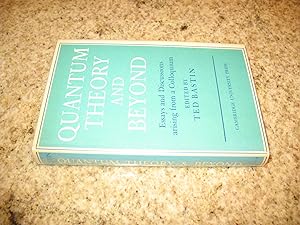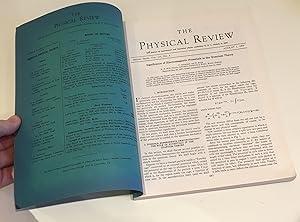Aharonov Yakir Bohm David (3 results)
FeedbackSearch filters
Product Type
- All Product Types
- Books (3)
- Magazines & Periodicals (No further results match this refinement)
- Comics (No further results match this refinement)
- Sheet Music (No further results match this refinement)
- Art, Prints & Posters (No further results match this refinement)
- Photographs (No further results match this refinement)
- Maps (No further results match this refinement)
- Manuscripts & Paper Collectibles (No further results match this refinement)
Condition
- All Conditions
- New (No further results match this refinement)
- Used (3)
Binding
Collectible Attributes
- First Edition (3)
- Signed (No further results match this refinement)
- Dust Jacket (1)
- Seller-Supplied Images (3)
- Not Print on Demand (3)
Language (2)
Price
- Any Price
- Under £ 20 (No further results match this refinement)
- £ 20 to £ 35 (No further results match this refinement)
- Over £ 35
Free Shipping
- Free Shipping to United Kingdom (No further results match this refinement)
Seller Location
Seller Rating
-
Quantum Theory and Beyond: Essays and Discussions Arising From a Colloquium
Published by Cambridge University Press, Cambridge, 1971
ISBN 10: 052107956X ISBN 13: 9780521079563
Language: English
Seller: Arroyo Seco Books, Pasadena, Member IOBA, Pasadena, CA, U.S.A.
Association Member: IOBA
First Edition
£ 107.67
Convert currency£ 43.31 shipping from U.S.A. to United KingdomQuantity: 1 available
Add to basketBlue Cloth. Condition: Fine. Dust Jacket Condition: Fine DJ. First Edition. 345 Pp. Blue Cloth, Gilt. First Printing. Fine In A Fine Price-Clipped Dj.
-
The Physical Review / Second Series / Volume 134 / Number 6B / 22 June 1964 / Bohm, David & Aharanov, Yakir (Time Energy Indeterminacy ); Aharonov, Yakir, Lebowitz, Joel L. and Bergmann, Peter G. (Time Symmetry in Quantum Measurement); Feinberg, Gerald (Mass & Iinteractions of the W Meson); Mehta, Mada Lal (Calculation of [particles] mass and width); Ne'eman, Yuval (Origins of the Mass Breaking Asymmetry)
Published by American Institute of Physics (for the American Physical Society), Lancaster, PA and New York, 1964
Language: English
Seller: Singularity Rare & Fine, Baldwinsville, NY, U.S.A.
First Edition
£ 380.69
Convert currency£ 59.73 shipping from U.S.A. to United KingdomQuantity: 1 available
Add to basketSoft cover. Condition: Very Good Plus. 1st Edition. Lancaster, PA and New York: American Institute of Physics (for the American Physical Society), 1964. First Edition thus. 22 - June 1964 issue. Quarto, light blue printed adhered wraps, pp B 1185 through B 1440 for the series are in this volume.Very Good plus. Minor water stain at lower front and rear covers, not affecting textblock. Original owner's name penned at top. No interior markings. See rear cover scan for the rich contents of this issue, but some include: Bohm, David & Aharanov, Yakir (Time Energy Indeterminacy ); Aharonov, Yakir, Lebowitz, Joel L. and Bergmann, Peter G. (Time Symmetry in Quantum Measurement); Feinberg, Gerald (Mass & Iinteractions of the W Meson); Mehta, Mada Lal (Calculation of [particles] mass and width); Ne'eman, Yuval (Origins of the Mass Breaking Asymmetry) L67.
-
Significance of Electromagnetic Potentials in the Quantum Theory, pp. 485-91 in Physical Review Vol. 115, No. 3, August 1, 1959. THE AHARONOV-BOHM EFFECT
Published by Lancaster, PA & New York, NY: American Physical Society, 1959
Seller: Landmarks of Science Books, Richmond, United Kingdom
First Edition
Soft cover. Condition: Near Fine. 1st Edition. First edition, complete journal issues in original printed wrappers, of the Aharonov-Bohm effect. In classical electromagnetic theory, all electromagnetic effects on charged particles can be obtained from a knowledge of the electric and magnetic fields 'seen' by the particle, that is, the fields at the position of the particle; the electromagnetic vector potential A is introduced purely as an auxiliary function to simplify some of the calculations. However, in quantum mechanics the situation is different. Consider an experimental arrangement in which a solenoid, regarded here as of infinite length, carries a finite steady current. The magnetic field produced by the current is entirely confined to the interior of the solenoid; outside it is zero. Now consider a beam of electrons which is split so as to pass on either side of the solenoid, and detected on a screen behind it. According to a quantum-mechanical calculation, the position of the interference fringes observed on the screen should depend on the current in the solenoid, despite the fact that there are no electric or magnetic fields at any point on the trajectories of the electrons! This strange behavior, usually known as the Aharonov Bohm effect, can be interpreted as showing either that the electrons can 'feel' fields even at points they never travel to, or that the vector potential has a 'physical reality' not envisaged in the classical electromagnetic theory. The Aharonov Bohm effect is important conceptually because it bears on three issues apparent in the recasting of (Maxwell's) classical electromagnetic theory as a gauge theory, which before the advent of quantum mechanics could be argued to be a mathematical reformulation with no physical consequences. The three issues are: whether potentials are "physical" or just a convenient tool for calculating force fields; whether action principles are fundamental; the principle of locality. Because of reasons like these, the Aharonov Bohm effect was chosen by the New Scientist magazine as one of the 'seven wonders of the quantum world'. Large 8vo, pp. 485-764. Original printed wrappers.



![Seller image for The Physical Review / Second Series / Volume 134 / Number 6B / 22 June 1964 / Bohm, David & Aharanov, Yakir (Time Energy Indeterminacy ); Aharonov, Yakir, Lebowitz, Joel L. and Bergmann, Peter G. (Time Symmetry in Quantum Measurement); Feinberg, Gerald (Mass & Iinteractions of the W Meson); Mehta, Mada Lal (Calculation of [particles] mass and width); Ne'eman, Yuval (Origins of the Mass Breaking Asymmetry) for sale by Singularity Rare & Fine](https://pictures.abebooks.com/inventory/md/md10299476928.jpg)
